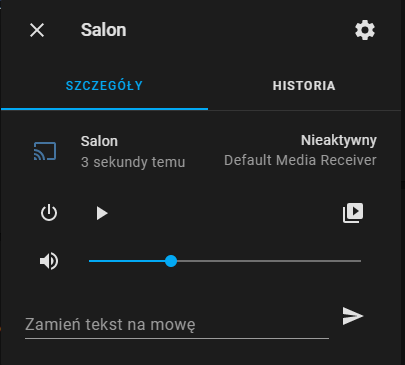Mam skonfigurowany głosnik Google Home mini z Google Cloud i dziala bez problemu moge wydawac mu polecenia i swiatla zapala.

Z poziomu dashbordu moge go włączyć i zmienić głośność ale jeśli chce puścić jakaś muzykę albo w pole tekstowe wpisać co ma powiedzieć to nie działa. I odkładają się błędy w logu ale za bardzo nie mogę dojść dlaczego. Logi ponizej
##################
Szczegóły loga (BŁĘDY)
Logger: homeassistant.components.websocket_api.http.connection
Source: helpers/network.py:116
Integration: Home Assistant WebSocket API (documentation, issues)
First occurred: 20:26:39 (1 occurrences)
Last logged: 20:26:39
[2937240112]
Traceback (most recent call last):
File “/usr/src/homeassistant/homeassistant/components/websocket_api/commands.py”, line 185, in handle_call_service
await hass.services.async_call(
File “/usr/src/homeassistant/homeassistant/core.py”, line 1491, in async_call
task.result()
File “/usr/src/homeassistant/homeassistant/core.py”, line 1526, in _execute_service
await handler.job.target(service_call)
File “/usr/src/homeassistant/homeassistant/helpers/entity_component.py”, line 213, in handle_service
await self.hass.helpers.service.entity_service_call(
File “/usr/src/homeassistant/homeassistant/helpers/service.py”, line 658, in entity_service_call
future.result() # pop exception if have
File “/usr/src/homeassistant/homeassistant/helpers/entity.py”, line 760, in async_request_call
await coro
File “/usr/src/homeassistant/homeassistant/helpers/service.py”, line 695, in _handle_entity_call
await result
File “/usr/src/homeassistant/homeassistant/components/cast/media_player.py”, line 476, in async_play_media
hass_url = get_url(self.hass, prefer_external=True)
File “/usr/src/homeassistant/homeassistant/helpers/network.py”, line 116, in get_url
raise NoURLAvailableError
homeassistant.helpers.network.NoURLAvailableError
####################
Logger: pychromecast.controllers.media
Source: helpers/network.py:123
First occurred: 20:26:36 (1 occurrences)
Last logged: 20:26:36
Exception thrown when calling media status callback
Traceback (most recent call last):
File “/usr/local/lib/python3.8/site-packages/pychromecast/controllers/media.py”, line 488, in _fire_status_changed
listener.new_media_status(self.status)
File “/usr/src/homeassistant/homeassistant/components/cast/helpers.py”, line 155, in new_media_status
self._cast_device.new_media_status(media_status)
File “/usr/src/homeassistant/homeassistant/components/cast/media_player.py”, line 300, in new_media_status
tts_base_url = self.hass.components.tts.get_base_url(self.hass)
File “/usr/src/homeassistant/homeassistant/components/tts/init.py”, line 651, in get_base_url
return hass.data[BASE_URL_KEY] or get_url(hass)
File “/usr/src/homeassistant/homeassistant/helpers/network.py”, line 83, in get_url
request_host = _get_request_host()
File “/usr/src/homeassistant/homeassistant/helpers/network.py”, line 123, in _get_request_host
raise NoURLAvailableError
homeassistant.helpers.network.NoURLAvailableError
#########
Jeszcze z configuration.yaml ustawienia
tts:
- platform: google_cloud
key_file: smarthome-306221-8136af63e241.json
language: pl-PL
gender: female
voice: pl-PL-Standard-D
encoding: linear16
speed: 0.9
pitch: 0.0
text_type: ssml
profiles:
- small-bluetooth-speaker-class-device
Dzięki za pomoc
Zenon
 . U mnie jest tylko tyle:
. U mnie jest tylko tyle: